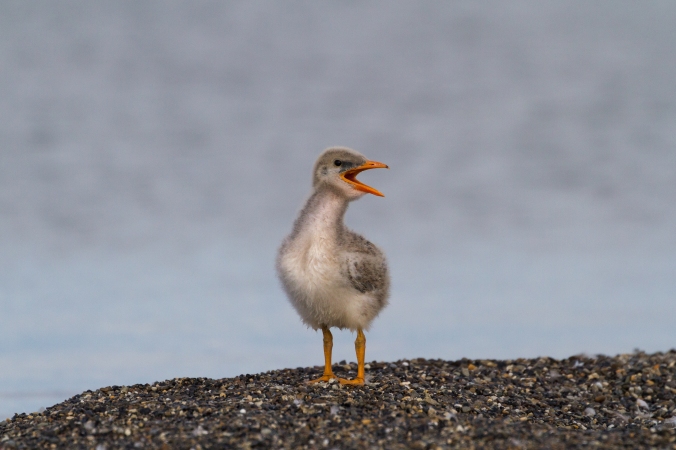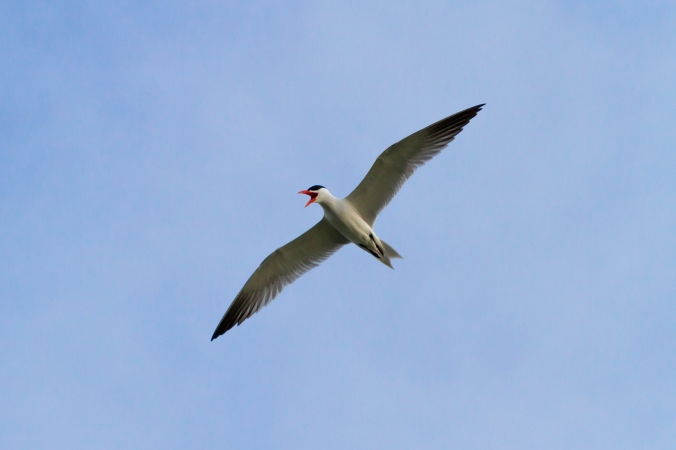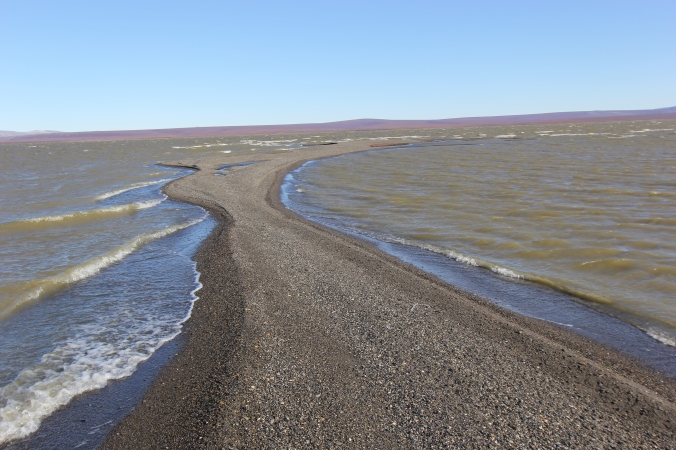
First photo of a Caspian tern chick in Arctic Alaska. This photo was one of two chicks on the island. The breeding pair was first discovered on July 23rd, this photo was taken July 26, 2016 by Kevin Rodriguez.
Arctic coastal lagoons are incredibly important for a diversity of breeding birds. Arctic lagoons are key habitat for feeding, nesting, molting and chick rearing for Pacific, red-throated and yellow-billed loons; waterfowl species such as longtail ducks, white-fronted geese and common eiders; shorebirds such as western and semipalmated sandpipers and black turnstones, and tern species including Arctic and Aleutian Terns. However, there is a new species of bird that is now relying on Arctic Lagoons.

Adult Caspian tern at Cape Krusenstern, 2016. Photo by Kevin Rodriguez.
While sampling the physical properties of water at Cape Krusenstern Lagoon in late July, a strange call drew our attention. Up until then, it was an unfamiliar noise in the Arctic; but for the rest of the summer it occasionally punctuated our day as we sampled lagoons as part of a Vital Signs Program for the National Park Service. That noise was the call of a Caspian tern, investigating us as we came close to a small sandy island in the lagoon. We approached the island to find that the terns had two healthy chicks. We were surprised to see breeding Caspian terns, knowing that this was far beyond their known breeding range. We revisited the island to check on the tern chicks through the rest of the season. Monitoring their progress, we were excited to see that the chicks fledged. On regular occasions after the chicks fledged, we saw either one or two chicks flying around the lagoon with their parents.

Adult Caspian tern breeding on a small island in Cape Krusenstern Lagoon. Photo by Kevin Rodriguez.
As a consequence, Cape Krusenstern National Monument now hosts the first known breeding Caspian terns in the Arctic (defined here as above the Arctic Circle). The Caspian terns breeding on Krusenstern Lagoon are almost 600 km further north from the previously recorded most northerly nesting location at Neragon Island in the Bering Sea. The breeding pair also represents the first Caspian terns observed breeding in the Chukchi Sea basin. The success of the breeding Caspian terns in the Arctic is likely related to the expanding growing season. Compared to most terns, Caspian terns have a longer incubation period and chicks grow more slowly. Warming in the Arctic has resulted in a dramatically longer ice free season and potential shifts in prey base that have been accompanied by major shifts of seabird species (Gall et al. 2016) and their ecology (Divoky et al. 2015). The ice-free season may only recently be long enough for Caspian terns to complete the long process of breeding. As Caspian terns continue to expand their range northward, we shouldn’t be surprised to find our successful pair being joined by other Caspian terns as they increase their presence in the Arctic.

The small island in Cape Krusenstern Lagoon used by a breeding pair of Caspian terns. Photo by Trevor Haynes.
http://www.sciencedirect.com/science/article/pii/S007966111500107X
Divoky, G.J., P.M. Lukacs and M.L. Druckenmiller. 2015. Effects of recent decreases in arctic sea ice on an ice-associated marine bird. Progress in Oceanography 136: 151–161
Gall, A.E., T.C. Morgan, R.H. Day and K.J. Kuletz. 2016. Ecological shift from piscivorous to planktivorous seabirds in the Chukchi Sea, 1975–2012. Polar Biology: 1–18
Written by Trevor Haynes, Wildlife Conservation Society. November 8, 2016.